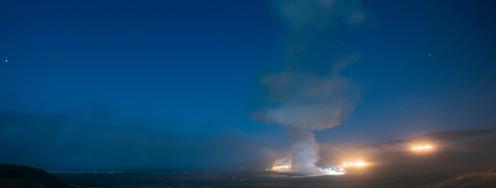Compromise Needed as JPOA Deadline Approaches
On the radar: The enrichment question and the Iran nuclear negotiations; Despite progress, PMD investigation needs more time; Empty quiver implications; the Threat of nuclear terrorism is real; BMD in Asia; and Russia conducts missile drills along NATO borders.
June 3, 2014 | Edited by Lauren Mladenka and Geoff Wilson
The enrichment challenge - “A long-sought deal between Iran and six world powers on a comprehensive, multiyear agreement to ensure Iran’s nuclear program is exclusively peaceful is within reach if the parties pursue realistic solutions on the major issues,” writes Daryl Kimball in Arms Control Today. “The two sides appear to have found common ground in some areas, such as modifying Iran’s Arak heavy-water reactor to significantly reduce its plutonium output and expanding International Atomic Energy Agency (IAEA) monitoring. But time is running short. China, France, Germany, Russia, the United Kingdom, and the United States, known collectively as the P5+1, and Iran have but a few weeks to close the gaps on other issues by their July 20 target date.”
--“Iran and the P5+1 should be able to agree that Iran will limit uranium enrichment to levels of less than 5 percent, keep stocks of its enriched uranium near zero, and halt production-scale work at the smaller Fordow enrichment plant and convert it to a research-only facility. Yet, the two sides must find a formula that limits Iran’s uranium-enrichment capacity at the Natanz site in a way that precludes an Iranian dash to produce enough highly enriched uranium (HEU) for weapons without being detected and disrupted but allows for Iran’s ‘practical’ civilian needs, as the Nov. 24 interim agreement between Iran and the P5+1 puts it.”
--“Concluding an effective comprehensive agreement will require difficult compromises on the major issues for both sides. But solutions that prevent a nuclear-armed Iran and still provide Iran with the means to pursue a civil nuclear program are achievable.” Read the full analysis here. http://bit.ly/1hVxrKX
Tweet - @tparsi: Great #WSJ coverage of @EllieGeranmayeh excellent new report on EU & #Iran http://on.wsj.com/1p3PYtq
Conflicting schedules - “The head of the U.N. nuclear agency suggested Monday that a probe of suspected atomic arms work by Iran may stretch into next year — which would push Tehran's overall nuclear agreement with world powers long past the July 20 target date,” reports George Jahn for the AP. “The International Atomic Energy Agency investigation is formally separate from six-power talks with Iran that are meant to build on a first step-accord struck late last year and focus on substantially trimming Tehran's nuclear program in exchange for full sanctions relief.”
--That being said, “the U.S. and its western allies at the negotiating table insist that Iran and the IAEA must wrap up the investigation as part of the overall nuclear agreement that Iran and the powers want to finalize by July 20. On Monday, IAEA chief Yukiya Amano told reporters he doesn't believe either side expects his agency to conclude its probe by then — raising new doubts about the deadline. He could not say if the investigation would finish by year's end. Speaking to the 35-nation IAEA board, Amano said Iran is cooperating ‘substantively’ with the probe, but it is too early to make an overall judgment.” Full report here. http://abcn.ws/1iMtMPH
An empty quiver - “U.S. ICBM forces were recently in the news again, and, as too often seems to be the case lately, the news was not good,” writes Eryn MacDonald for All Things Nuclear. “The latest report concerns an Air Force security team at Malmstrom Air Force Base in Montana (also the home of the cheating scandal and drug investigation) that last summer failed an exercise designed to test its ability to respond to the simulated capture of an ICBM silo. While the failure was reported at the time of the exercise, it was not clear that this was because of a security problem. Now more details have come out about what actually happened.”
--“Malmstrom is home to 150 of the Air Force’s 450 missile silos housing Minuteman III ICBMs. Each silo contains a missile armed with a nuclear warhead that is constantly on high alert, ready to launch in minutes if the president gives the order. The exercise last summer reportedly required the security team to recapture a silo after it had been seized by intruders. The team failed the test when it was unable to retake the silo quickly enough to satisfy the requirements of the exercise. According to an internal Air Force review document obtained by the Associated Press, the security team did not take ‘all lawful actions necessary to immediately regain control of a nuclear weapon.’ Because of the potentially huge consequences if a nuclear weapon were to fall into the wrong hands, this was, not surprisingly, labeled a ‘critical deficiency.’ The officer in charge of the security forces was fired shortly after the failed exercise.”
--“Given the inherent ambiguity and potential for confusion in any security incident, the explanation from Colonel Robert Stanley, who was commander of the missile wing at the time, for why the security team failed is even more interesting. Stanley said that the simulation was done ‘in a way that we’ve never seen before,’ and that ‘it confused our airmen.’ [But] surely the point of such an exercise is (or should be) to test the security forces in a situation that is as realistic as possible? And, if so, surprise and confusion are par for the course.” In the post-9/11 world, the United States ‘no longer has the luxury of assuming what is and is not possible.’ In this case, the security force’s ability to respond to novel or surprising situations would seem to be critical. And yet that’s what it apparently failed to do.” Read the full piece here. http://bit.ly/1nKLCuh
The threat is real - “The gravest threat to the security of the United States and the world is a terrorist obtaining a nuclear weapon,” writes former Sen. Sam Nunn (D-GA) in The Hill. “We know that acquiring a weapon or the nuclear-explosive material to make one is the hardest step for terrorists to take and the easiest step for us to stop. By contrast, every subsequent step in the process—building the bomb, transporting it, and detonating it—is easier for the terrorists to take and harder for us to stop. The bottom line: Securing nuclear materials at the source is the most effective, least expensive way to prevent nuclear terrorism.”
--“There will be a large price to be paid in diminished U.S. and global security if cooperation in this area slows down or comes to a halt. Yet, funding for these critical programs has declined rapidly, with the Administration’s FY15 budget request proposing an approximate 25 percent reduction. In fact, this would be the third year in a row that these critical nonproliferation programs have been cut. We must view our nuclear and radiological threat reduction efforts as a core component of our national security strategy and not as a contingency fund for financing other security programs. Surely, preventing nuclear terrorism should be at the top of our list of national security and budgetary priorities. The threat of nuclear terrorism is real. The need to work urgently—and in a smart way—is real. This is a critical global challenge that requires all countries to work together. We are in a race between cooperation and catastrophe.” Read the full article here. http://bit.ly/1nKMPSm
Cooperative networks - “The United States and its East Asia allies on Saturday agreed to further study possible trilateral information exchanges about the North Korean missile threat,” reports Rachel Oswald for Global Security Newswire. “The heads of defense for Washington, Seoul and Tokyo during a three-way discussion in Singapore ‘reaffirmed the importance of information sharing on North Korea nuclear and missile threats and shared an understanding that this issue needs to be reviewed further,’ says a joint statement released after the meeting.”
--“No mention was made in the statement from U.S. Defense Secretary Chuck Hagel, Japanese Defense Minister Itsunori Onodera and South Korean Defense Minister Kim Kwan-jin about an official agreement being reached that would enable the direct sharing between Japan and South Korea of sensor data related to North Korean missile launches. Such a pact was earlier envisioned to result from the sit-down, which happened on the margins of the annual Shangri-La Dialogue in Singapore… While the South appears to be ‘willing to go along’ with the goal of achieving system interoperability with Japan and the United States, for now ‘they are not willing to have a permanently fixed, integrated early-warning and shoot-to-kill missile system’ with the two countries… U.S. antimissile cooperation with Japan, meanwhile, is already further along. The United States is scheduled by the end of the year to deploy the second of two early-warning radars on Japanese territory and is slated by 2017 to redeploy two more Aegis-equipped warships to the island country.” Full report here. http://bit.ly/1o3KeR8
On the other hand - “The commander of U.S. troops stationed in South Korea said on Tuesday he had proposed deploying an advanced missile-defense system to the country, to counter the growing threat of North Korea’s weapons capabilities,” Reuters reports. “In March, the North test fired a mid-range Rodong missile with a range of more than 1,000 km (600 miles), prompting condemnation from the U.N. Security Council, and being seen as preparing to conduct a fourth nuclear test. U.S. General Curtis Scaparrotti, the commander of U.S. forces in South Korea, was quoted as saying ‘I recommended the deployment of the THAAD (Theater High Altitude Area Defense) missiles to South Korea.’"
--“The top U.S. military official also acts as the head of the combined command leading South Korea and U.S. forces defending the South, which remains technically at war with North Korea under a truce that ended the 1950-53 Korean War. The United States has carried out a site survey in South Korea for possible locations for the THAAD battery, but no final decisions have been made to deploy the system, media have reported… South Korea has so far opted not to be part of the U.S. missile defense partnership that covers the defense of Japan from the North's missile threats. Instead, it has been developing its own independent anti-missile system, the Korean Air and Missile Defense System (KAMD).” Full report here. http://reut.rs/1pCvBpP
Tweet - @globalzero: The most powerful #nuclear bomb ever detonated, the Tsar Bomba, was 25x more powerful than all the explosives used in WWII combined.
Missile test - “Russia on Monday announced that it was conducting ballistic missile drills in its western segment of the country, which neighbors multiple NATO states,” Global Security Newswire reports. "’A missile formation of the Western Military District armed with [the] tactical missile system Iskander-M and long-range warplanes will participate in the war games,’ the Russian defense ministry informed ITAR-Tass on Monday in describing the exercises that were slated to last from May 27 through June 5.”
--“Russia's Western Military District includes the Kaliningrad region, an exclave that borders NATO member states Poland and Lithuania. It was not apparent from the government announcement whether any Iskander missiles would be located in the Kaliningrad region for the drill. The potential deployment of nonstrategic nuclear-capable Iskander missiles to the exclave is a concern for Warsaw and Vilnius. In recent years, Moscow has warned that it would send Iskander systems to the small region as a response to the evolving NATO ballistic missile shield.” Full story here. http://bit.ly/1iP6bxI
Quick-hit:
--“Chocks away! Climb inside a real nuclear bomber plane” by Zoah Hedges-Stocks in London 24. http://bit.ly/1p4aIBk
Events:
--“Chain Reaction 2014.” Ploughshares Fund Gala with Michael Douglas, Jeremy Ben-Ami and Trita Parsi. June 3 from 6:00 to 8:30 at The Open Square at Futures Without Violence, 100 Montgomery Street, The Presidio of San Francisco. Purchase tickets here. http://bit.ly/1nexkld
--“Plutonium Disposition by Downblending and Disposal.” Discussion with Edwin Lyman and Miles Pomper. June 4 from 9:00-10:45 at the American Association for the Advancement of Science, Abelson-Haskins Conference Room, 1200 New York Ave., NW. RSVP here. http://adobe.ly/1gYCbnT
--“U.S. Missile Defense Developments: How Far? How Fast?” Discussion with Cristina Chaplain, Phil Coyle, Laura Grego, and James Miller; moderated by Steven Pifer. June 4 from 10:00-11:30am at the Brookings Institution, Saul/Zilkha Rooms, 1775 Massachusetts Ave., NW. RSVP here. http://bit.ly/1lUd81A
--“Israel, Saudi, and Iranian Responses in the Days After a Deal With Iran.” Discussion with Alireza Nader, Dalia Dassa Kaye, and Jeffrey Martini. Moderated by Lynne Davis. June 4 from 1:00 to 2:00 at 2200 Rayburn House Office Building. RSVP here. http://bit.ly/RBn07W
--“Nuclear Strategy in the Modern Era: India, Pakistan, China and the Future of Deterrence Stability." Discussion with Vipin Narang and Peter Lavoy. June 4 from 3:00 to 4:30 at the Stimson Center, 1111 19th St., NW, Floor 12. RSVP here. http://bit.ly/1h9mbzS
--“Nuclear Flashpoints: U.S.-Iran Tensions Over Terms and Timetables.” Discussion with Stephen Hadley, Jon Wolfsthal, Daryl Kimball and Robert Litwak. June 10 from 9:30 to 11:00 at the Wilson Center, 1300 Pennsylvania Ave., NW, floor 6. RSVP here. http://bit.ly/1tqM3Hk
--“War With Iran? Should the United States Use Military Force Against Iran if Nuclear Diplomacy Fails?” Debate with Georgetown University and University of Michigan students; comments by Colin Kahl. June 13 from 9:00-12:00 at the Willard Intercontinental Hotel, The Willard Room, 1401 Pennsylvania Ave. NW. RSVP here. http://bit.ly/1gXWlOJ



